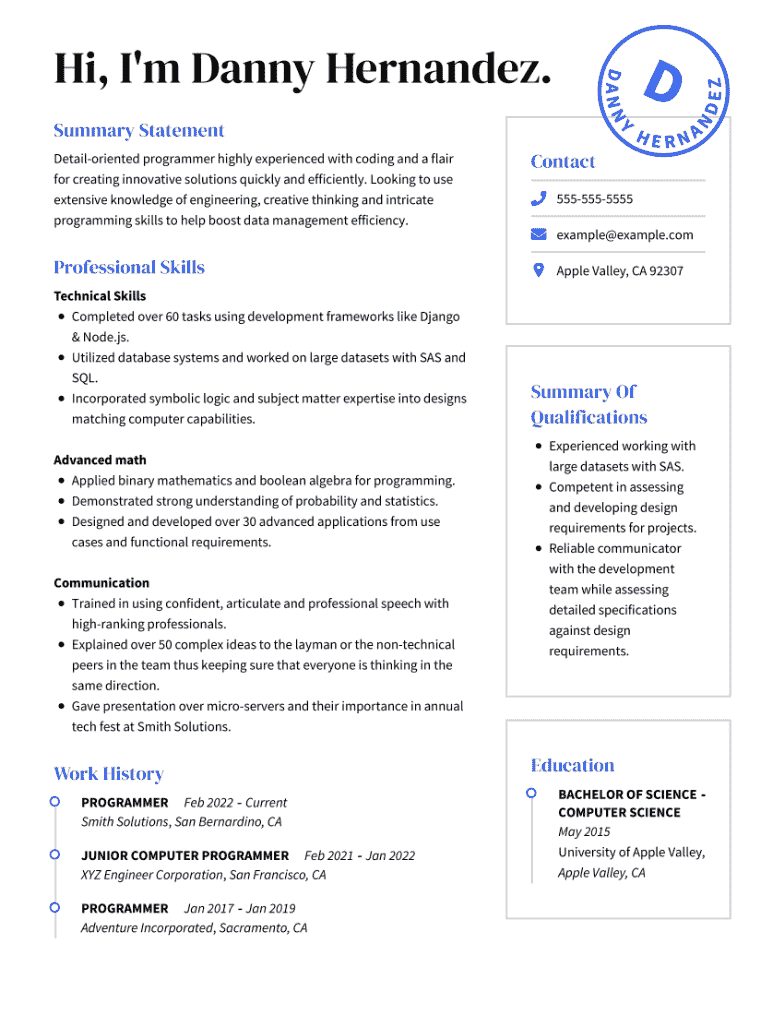Programmer CV Examples to Help You Build Yours
To be a programmer, you need to have an in-depth understanding of your chosen programming language. How can you make sure that gets across?
To be a programmer, you need to have an in-depth understanding of your chosen programming language. How can you make sure that gets across?





OUR USERS HAVE BEEN HIRED BY

Your CV structure will depend on the CV format that you choose. You can choose the chronological CV which emphasises work history or the functional CV (skills-based) format which emphasises skills when you don’t have extensive work history. Many CV templates start with a chronological CV. Regardless of the CV format you choose, you’re going to include these sections:
Header
Your programmer CV header is the top section of the CV. Typically, it includes your full name, phone number, email address and any job networking profile links such as LinkedIn. This placement at the top of your CV ensures that a hiring manager knows how to contact you for an interview if needed.
Personal statement summary
The personal statement (CV summary) gives hiring managers an overview of your specific skills and work history. It is typically a paragrah highlighting your best points. Since it’s positioned at the top of the CV, it’s a great place to begin showcasing why you are the right candidate for this programming job.
Relevant skills
You’ll generally want to list at least 5-6 relevant skills on your programmer CV. Here are a few of the computer skills that you’re likely to use:
Of course, in programming, a significant number of the skills are hard skills, not soft skills. Although some soft skills are important, like problem solving skills, the general overwhelming number of skills on your list will revolve around your actual technical knowledge.
Work history
If you have previous programming experience, you’ve worked for information technology (IT) or you have other related experience, you will include it in the work history section of your CV. Work history is the best way to showcase that you are qualified, in addition to your certifications. You can optimise your CV by making sure that it includes all relevant previous work experience.
Education
Although not all programmers have an extensive education section, always include your top accreditation, such as a bachelor’s degree in computer science, along with any honours you graduated with. Remember, your education doesn’t guarantee you’ll get the job, but it can be a solid addition to your CV.
Do:
Don’t:
Yes. It’s important to use a cover letter to show the hiring manager why you are the perfect fit for the job. If you’re not sure about how to create a cover letter, just use the CVHelp cover letter builder. A good cover letter can elaborate on your skills and experience and make you stand out from candidates who did not write one.
If you don’t have a lot of experience in the field, focus on your relevant skills and training. If you don’t have existing programmer experience, you’ll want to work on projects of your own to impress a hiring manager.
Read the job application carefully, noting the exact wording of the skills they’re looking for in an expert. Then, incorporate those exact keywords into your CV. This is an effective way to get through an applicant tracking system (ATS) more effectively.
We personalize your experience.
We use cookies in our website to ensure we give you the best experience, get to know our users and deliver better marketing. For this purpose, we may share the information collected with third parties. By clicking “Allow cookies” you give us your consent to use all cookies. If you prefer to manage your cookies click on the “Manage cookies” link below.